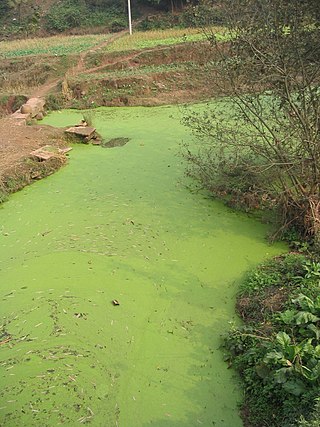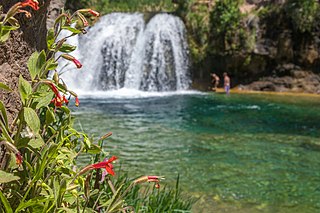Related Research Articles

Eutrophication is a general term describing a process in which nutrients accumulate in a body of water, resulting in an increased growth of microorganisms that may deplete the water of oxygen. Although eutrophication is a natural process, manmade or cultural eutrophication is far more common and is a rapid process caused by a variety of polluting inputs including poorly treated sewage, industrial wastewater, and fertilizer runoff. Such nutrient pollution usually causes algal blooms and bacterial growth, resulting in the depletion of dissolved oxygen in water and causing substantial environmental degradation.

A wetland is a distinct ecosystem that is flooded or saturated by water, either permanently for years or decades or seasonally for a shorter periods. Flooding results in oxygen-free anoxic processes prevailing, especially in the soils. The primary factor that distinguishes wetlands from terrestrial land forms or water bodies is the characteristic vegetation of aquatic plants, adapted to the unique anoxic hydric soils. Wetlands are considered among the most biologically diverse of all ecosystems, serving as home to a wide range of plant and animal species. Methods for assessing wetland functions, wetland ecological health, and general wetland condition have been developed for many regions of the world. These methods have contributed to wetland conservation partly by raising public awareness of the functions some wetlands provide. Constructed wetlands are designed and built to treat municipal and industrial wastewater as well as to divert stormwater runoff. Constructed wetlands may also play a role in water-sensitive urban design.

The benthic zone is the ecological region at the lowest level of a body of water such as an ocean, lake, or stream, including the sediment surface and some sub-surface layers. The name comes from ancient Greek, βένθος (bénthos), meaning "the depths." Organisms living in this zone are called benthos and include microorganisms as well as larger invertebrates, such as crustaceans and polychaetes. Organisms here generally live in close relationship with the substrate and many are permanently attached to the bottom. The benthic boundary layer, which includes the bottom layer of water and the uppermost layer of sediment directly influenced by the overlying water, is an integral part of the benthic zone, as it greatly influences the biological activity that takes place there. Examples of contact soil layers include sand bottoms, rocky outcrops, coral, and bay mud.

Tailwater refers to waters located immediately downstream from a hydraulic structure, such as a dam, spillway, bridge or culvert. Generally measured and reported as the average water depth downstream of a hydraulic structure, tailwater can vary based on the outlet from the structure as well as downstream influences that may restrict or advance the usual flow of water from the structure. The creation of a tailwater will have significant impacts on both the abiotic and biotic conditions of the waterway.

A riparian zone or riparian area is the interface between land and a river or stream. In some regions, the terms riparian woodland, riparian forest, riparian buffer zone, riparian corridor, and riparian strip are used to characterize a riparian zone. The word riparian is derived from Latin ripa, meaning "river bank".

River ecosystems are flowing waters that drain the landscape, and include the biotic (living) interactions amongst plants, animals and micro-organisms, as well as abiotic (nonliving) physical and chemical interactions of its many parts. River ecosystems are part of larger watershed networks or catchments, where smaller headwater streams drain into mid-size streams, which progressively drain into larger river networks. The major zones in river ecosystems are determined by the river bed's gradient or by the velocity of the current. Faster moving turbulent water typically contains greater concentrations of dissolved oxygen, which supports greater biodiversity than the slow-moving water of pools. These distinctions form the basis for the division of rivers into upland and lowland rivers.

Prairie restoration is a conservation effort to restore prairie lands that were destroyed due to industrial, agricultural, commercial, or residential development. The primary aim is to return areas and ecosystems to their previous state before their depletion.

Fossil Creek is a perennial stream accessed by forest roads near the community of Camp Verde in the U.S. state of Arizona. Primary access is from Forest Road 708 off Arizona State Route 260 east of Camp Verde. A tributary of the Verde River, Fossil Creek flows from its headwaters on the Mogollon Rim to meet the larger stream near the former Childs Power Plant.

A beaver dam or beaver impoundment is a dam built by beavers; it creates a pond which protects against predators such as coyotes, wolves and bears, and holds their food during winter. These structures modify the natural environment in such a way that the overall ecosystem builds upon the change, making beavers a keystone species and ecosystem engineers. They build prolifically at night, carrying mud with their forepaws and timber between their teeth.

The environmental impact of reservoirs comes under ever-increasing scrutiny as the global demand for water and energy increases and the number and size of reservoirs increases.

Dam removal is the process of demolishing a dam, returning water flow to the river. Arguments for dam removal consider whether their negative effects outweigh their benefits. The benefits of dams include hydropower production, flood control, irrigation, and navigation. Negative effects of dams include environmental degradation, such as reduced primary productivity, loss of biodiversity, and declines in native species; some negative effects worsen as dams age, like structural weakness, reduced safety, sediment accumulation, and high maintenance expense. The rate of dam removals in the United States has increased over time, in part driven by dam age. As of 1996, 5,000 large dams around the world were more than 50 years old. In 2020, 85% percent of dams in the United States are more than 50 years old. In the United States roughly 900 dams were removed between 1990 and 2015, and by 2015, the rate was 50 to 60 per year. France and Canada have also completed significant removal projects. Japan's first removal, of the Arase Dam on the Kuma River, began in 2012 and was completed in 2017. A number of major dam removal projects have been motivated by environmental goals, particularly restoration of river habitat, native fish, and unique geomorphological features. For example, fish restoration motivated the Elwha Ecosystem Restoration and the dam removal on the river Allier, while recovery of both native fish and of travertine deposition motivated the restoration of Fossil Creek.

The Elwha Ecosystem Restoration Project is a 21st-century project of the U.S. National Park Service to remove two dams on the Elwha River on the Olympic Peninsula in Washington state, and restore the river to a natural state. It is the largest dam removal project in history and the second largest ecosystem restoration project in the history of the National Park Service, after the Restoration of the Everglades. The controversial project, costing about $351.4 million, has been contested and periodically blocked for decades. It has been supported by a major collaboration among the Lower Elwha Klallam Tribe, and federal and state agencies.

Riparian-zone restoration is the ecological restoration of riparian-zonehabitats of streams, rivers, springs, lakes, floodplains, and other hydrologic ecologies. A riparian zone or riparian area is the interface between land and a river or stream. Riparian is also the proper nomenclature for one of the fifteen terrestrial biomes of the earth; the habitats of plant and animal communities along the margins and river banks are called riparian vegetation, characterized by aquatic plants and animals that favor them. Riparian zones are significant in ecology, environmental management, and civil engineering because of their role in soil conservation, their habitat biodiversity, and the influence they have on fauna and aquatic ecosystems, including grassland, woodland, wetland or sub-surface features such as water tables. In some regions the terms riparian woodland, riparian forest, riparian buffer zone, or riparian strip are used to characterize a riparian zone.

A nutrient cycle is the movement and exchange of inorganic and organic matter back into the production of matter. Energy flow is a unidirectional and noncyclic pathway, whereas the movement of mineral nutrients is cyclic. Mineral cycles include the carbon cycle, sulfur cycle, nitrogen cycle, water cycle, phosphorus cycle, oxygen cycle, among others that continually recycle along with other mineral nutrients into productive ecological nutrition.

A whitewater river is classified based on its chemistry, sediments and water colour. Whitewater rivers have high levels of suspended sediments, giving the water a pH that is near-neutral, a high electric conductivity and a pale muddy, café au lait-like colour. Whitewater rivers are of great ecological importance and are important to local fisheries. The major seasonal Amazonian floodplains known as várzea receive their water from them.
Emily Stanley is an American professor of limnology at the University of Wisconsin–Madison. She was named a 2018 Ecological Society of America Fellow and her research focuses on the ecology of freshwater ecosystems.
Amy D. Rosemond is an American aquatic ecosystem ecologist, biogeochemist, and Distinguished Research Professor at the Odum School of Ecology at the University of Georgia. Rosemond studies how global change affects freshwater ecosystems, including effects of watershed urbanization, nutrient pollution, and changes in biodiversity on ecosystem function. She was elected an Ecological Society of America fellow in 2018, and served as president of the Society for Freshwater Science from 2019-2020.

A marine coastal ecosystem is a marine ecosystem which occurs where the land meets the ocean. Marine coastal ecosystems include many very different types of marine habitats, each with their own characteristics and species composition. They are characterized by high levels of biodiversity and productivity.
Michelle Cailin Mack is an ecologist working on the connections between plants and climate in polar regions. She is a fellow of the Ecological Society of America and the American Geophysical Union. She currently holds the title of Regent's Professor at Northern Arizona University.
References
- ↑ Marks, Jane (1989). "The independent and interactive effects of snail grazing and nutrient enrichment on structuring periphyton communities". Hydrobiologia. 185: 9–17. doi:10.1007/BF00006063. hdl: 2027.42/42878 . S2CID 30748245.
- ↑ Marks, Jane (1993). "Interactive Effects of Nutrient Availability and Light Levels on the Periphyton Composition of a Large Oligotrophic Lake". Canadian Journal of Fisheries and Aquatic Sciences. 50 (6): 1270–1278. doi:10.1139/f93-144.
- ↑ Marks, Jane C.; Power, Mary E.; Parker, Michael S. (2000). "Flood disturbance, algal productivity, and interannual variation in food chain length". Oikos. 90 (1): 20–27. doi:10.1034/j.1600-0706.2000.900103.x. ISSN 1600-0706.
- ↑ "Fellow Directory | S&T Policy FellowsCentral". www.aaaspolicyfellowships.org. Retrieved 2021-11-04.
- ↑ Poppick, Laura (2020-08-06). "The life that springs from dead leaves in streams". Knowable Magazine | Annual Reviews. doi: 10.1146/knowable-080620-1 . S2CID 225466788 . Retrieved 2021-11-04.
- ↑ Reporter, ANNE MINARDSun Staff. "Will leaf litter unlock the Verde's secrets?". Arizona Daily Sun. Retrieved 2021-10-31.
- ↑ Marks, Jane C. (2019-11-02). "Revisiting the Fates of Dead Leaves That Fall into Streams". Annual Review of Ecology, Evolution, and Systematics. 50 (1): 547–568. doi:10.1146/annurev-ecolsys-110218-024755. ISSN 1543-592X. S2CID 203350090.
- ↑ Compson, Zacchaeus G.; Hungate, Bruce A.; Whitham, Thomas G.; Koch, George W.; Dijkstra, Paul; Siders, Adam C.; Wojtowicz, Todd; Jacobs, Ryan; Rakestraw, David N.; Allred, Kiel E.; Sayer, Chelsea K. (2018). "Linking tree genetics and stream consumers: isotopic tracers elucidate controls on carbon and nitrogen assimilation". Ecology. 99 (8): 1759–1770. doi:10.1002/ecy.2224. ISSN 1939-9170. PMID 29603188. S2CID 4494430.
- ↑ Marks, Jane (2007). "Down Go The Dams". Scientific American. 296 (3): 66–71. doi:10.1038/scientificamerican0307-66.
- ↑ Robin (2007-02-20). "Damned If You Dam, Damned If You Don't". Wall Street Journal. ISSN 0099-9660 . Retrieved 2021-10-31.
- ↑ Oct. 1, Michelle Nijhuis; Now, 2007 From the print edition Like Tweet Email Print Subscribe Donate (2007-10-01). "A downside to downing dams?". www.hcn.org. Retrieved 2021-10-31.
{{cite web}}: CS1 maint: numeric names: authors list (link) - ↑ "Researchers study effects of restored flow below dam". Arizona Daily Star. Retrieved 2021-10-31.
- ↑ "Scientists studies effects of dam removals". UPI. Retrieved 2021-10-31.
- ↑ Gibson, Catherine A.; Koch, Benjamin J.; Compson, Zacchaeus G.; Hungate, Bruce A.; Marks, Jane C. (2018-03-01). "Ecosystem responses to restored flow in a travertine river". Freshwater Science. 37 (1): 169–177. doi:10.1086/696614. ISSN 2161-9549. S2CID 89968979.
- ↑ Fuller, Brian M.; Sklar, Leonard S.; Compson, Zacchaeus G.; Adams, Kenneth J.; Marks, Jane C.; Wilcox, Andrew C. (2011). "Ecogeomorphic feedbacks in regrowth of travertine step-pool morphology after dam decommissioning, Fossil Creek, Arizona". Geomorphology. 126 (3–4): 314–332. doi:10.1016/j.geomorph.2010.05.010.
- 1 2 Marks, Jane C.; Haden, George A.; O’Neill, Matthew; Pace, Cinnamon (2010). "Effects of Flow Restoration and Exotic Species Removal on Recovery of Native Fish: Lessons from a Dam Decommissioning". Restoration Ecology. 18 (6): 934–943. doi:10.1111/j.1526-100X.2009.00574.x. S2CID 21724032.
- ↑ "Creative Flagstaff | 2021 Viola Awards" . Retrieved 2021-10-31.
- ↑ "With help of NAU experts, 'Parched' documentary brings urgency to Southwest water crisis – The NAU Review" . Retrieved 2021-10-31.
- ↑ "Spike Lee to visit NAU on Holocaust Remembrance Day – The NAU Review" . Retrieved 2021-10-31.
- ↑ "Former Green Party vice presidential candidate to speak on campus – The NAU Review" . Retrieved 2021-10-31.
- ↑ Reporter, HILLARY DAVIS Sun Staff. "Cornel West tells crowd at NAU that education matters". Arizona Daily Sun. Retrieved 2021-10-31.
- ↑ "Students debate SB1070". The Lumberjack. Retrieved 2021-10-31.
- ↑ "Open Letter from Arizona university faculty, administrators, and staff". sites.google.com. Retrieved 2021-10-31.
- ↑ Peralta, Eyder (2012-06-25). "Supreme Court Strikes Down Key Provisions Of Arizona Immigration Law". NPR. Retrieved 2021-10-31.